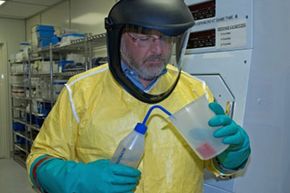Ionizing Radiation and the Damage Done
When we talk about the amount of radiation needed to trigger a certain set of radiation sickness symptoms, we're not talking in terms of absolute amounts. Instead, we're talking about the total dosage. This dosage takes a number of factors into account, including the intensity of the radiation, how much is absorbed by a typical human body, how long the body is exposed to the source, and what types of radiation are involved. The unit of measure that accounts for all of these factors is the sievert (Sv), which measures absorption of radioactive energy multiplied by a quality factor that changes depending on whether the radiation being measured is alpha particles, beta particles or gamma rays.
A burst dose of 0.75 Sv can be enough to induce radiation sickness, including nausea and a weakened immune system. Three sieverts will cause more severe effects but usually won't be fatal if you receive medical care. An instantaneous dose of 10 or more sieverts will be fatal, even with medical care. A dose somewhere in between gives you a roughly 50 percent chance of dying within 30 days. Remember that we're referring to an instantaneous, acute dose — if the same dose is spread out over a longer period of time, the effects will be reduced.
Advertisement
That might seem a little scary since it takes less than a single sievert to make you sick. For comparison, if you go to the hospital and get a CT scan, you'll receive slightly over 0.01 Sv of radiation. If you're a worker in a radiation-heavy environment, federal guidelines limit the maximum yearly dose to 0.05 Sv. According to the EPA, the average person receives around .0062 Sv each year, around half of which is from natural background radiation.
So, what does radiation sickness actually look like? Radiation sickness initially manifests with symptoms within a few minutes or hours of exposure; these symptoms include nausea, diarrhea, headache, fever and even, in severe cases, loss of consciousness. High doses also cause burns on the skin. Symptoms occur more quickly the greater the dose of radiation and will fade in one or two days. Following that is a latent period, a lull during which there are no symptoms. The latent period lasts several weeks, although the larger the dose, the shorter the latent period — and with exposures above roughly 10 Sv, there is no latent period.
Unfortunately, after the latent period, the real damage becomes evident. The radiation damages cells and structures within the body. Most vulnerable is bone marrow, where stem cells produce blood cells. Damaged marrow can't produce enough red or white blood cells, leaving the body anemic and susceptible to infections. Radiation also damages the cells that line the digestive system, not only preventing that system from functioning properly but allowing bacteria to migrate from the digestive tract into the blood, causing more infections.
What happens when an intense burst of radiation causes severe radiation sickness? We'll talk about that in the next section.
